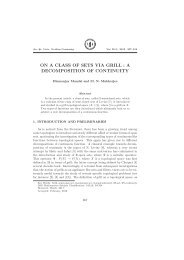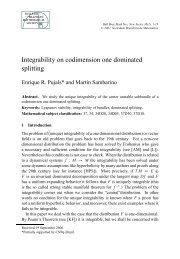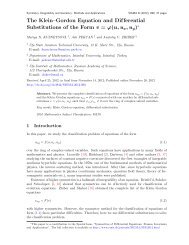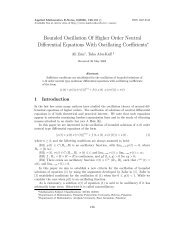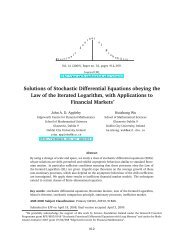ENRICHED INDEXED CATEGORIES Contents 1. Introduction
ENRICHED INDEXED CATEGORIES Contents 1. Introduction
ENRICHED INDEXED CATEGORIES Contents 1. Introduction
You also want an ePaper? Increase the reach of your titles
YUMPU automatically turns print PDFs into web optimized ePapers that Google loves.
<strong>ENRICHED</strong> <strong>INDEXED</strong> <strong>CATEGORIES</strong> 619cocomplete, profunctors between large categories may not be composable. 1 A reader whois so inclined can read parts of sections 5, 8, and 10 of this paper as contributions to thistheory, since wherever possible, we give proofs that apply in any virtual equipment.Finally, enriched indexed categories share with classical indexed categories the propertyof having multiple not-obviously-equivalent definitions. Given an indexed monoidalcategory V , there is an obvious notion of small V -category, which directly generalizesinternal categories and small enriched categories. On the other hand, there is also a fairlyobvious notion of (large) indexed V -category, which generalizes locally small indexed categories(incarnated as “locally internal categories” in the sense of [Pen74]). There areplenty of good examples of both definitions, but it is not entirely trivial how to regard asmall V -category as an indexed one!The equipment-theoretic approach actually yields a third notion, which we will callsimply a (large) V -category. This notion manifestly includes small V -categories as aspecial case, but its connection to indexed V -categories is not entirely trivial. In thespecial case of ordinary (unenriched) indexed categories, this relationship was establishedby [BCSW83, BW87]. Thus, we spend some time producing the analogous correspondencebetween indexed V -categories and large V -categories. It turns out to behave even betterwhen we work with equipments, rather than merely bicategories as [BCSW83, BW87] did.The nontriviality of this correspondence also means that it also takes a little work torephrase equipment-theoretic notions (such as weighted limits) in the language of indexedV -categories. Pleasingly, the results are exactly what one might hope for.<strong>1.</strong>2. Historical remarks. Apparently, the idea of enriched indexed categories wasfirst proposed by Lawvere [Law73]. A formal definition was given by Gouzou and Grunigin [GG76], corresponding to what I will call an “indexed V -category”. They did not applygeneral equipment-theoretic methods (which did not exist at that time). Perhaps becauseof a lack of applications, the definition did not become well-known, and the theory wasnot extensively developed.I discovered enriched indexed categories myself around 2007, with examples suchas [MS06] and [Pon07] in mind. Michal Przybylek [Prz07] independently invented themat about the same time as well. After a brief discussion on the categories mailing list,Thomas Streicher very kindly sent me a copy of the work of Gouzou and Grunig. Seeingthis, and not having any real applications in mind yet, and feeling that it was all a specialcase of equipment theory, I put the notion aside for a while.However, recently two new applications have appeared. Firstly, the notion of “globalequivariant spectrum” developed in [Boh12] requires categories that are both indexedover groups and enriched in spaces with group actions, and was made possible by an earlydraft of this paper. Secondly, during Octoberfest 2012 in Montreal, I found that MartaBunge had also independently arrived at the same notion of “indexed V -category”, withthe goal of comparing various idempotent completion monads [Bun13].1 In some of the literature, such as [SW78], this is avoided by invoking an embedding theorem tomake the enriching category into an even larger one. However, an analogous process for enriched indexedcategories would be rather more complicated and obscure the important ideas.



